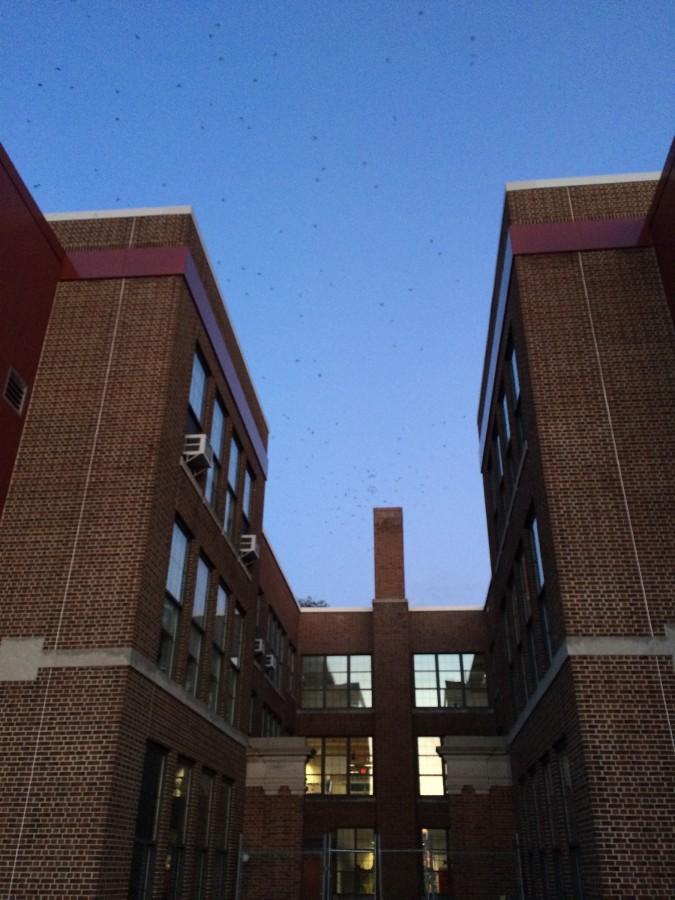“Cigars with Wings” – Chimney Swifts at Community
Nothing too exciting had happened in the minutes leading up to second block until around three hundred tiny, dark grayish birds shot out of the Community High School chimney and began circling over the school.
These birds—Chimney Swifts*—are not an unusual sight during the summer in Ann Arbor. From May to October, they can be seen, especially at dawn and dusk, flying in dizzying circles, and sometimes in large groups. “They forage for insects at high altitudes during the daytime, and at night, traditionally, they find a roost spot. During the summertime, it will be their nest site, and during spring and fall, they roost communally,” said Sarah Toner, a CHS senior. Toner is a co-leader of the CHS Ecology Club, and has been a birder for nearly a decade.
*Bird names are capitalized in scientific articles.
Chimney Swifts typically roost in chimneys—hence their name. “In the past, before the United States was a nation, Chimney Swifts would nest in the hollow trunks of trees, which, in the old growth forests, looked similar to chimneys,” said Toner. “They would be twenty, thirty feet tall and have a hollow center. However, since the clearing of the forests, we also cleared away the chimney-like dead snags that Chimney Swifts preferred to roost in.”
Chimney Swifts turned to the chimneys, the closest alternative. Chimneys provide similar protection for swifts, and over the past three centuries, they have adapted remarkably quickly. “At least in the eastern part of the country, now they are adapted to nesting in chimneys,” said Juliet Berger, the President of the Washtenaw Audubon Society.
Ann Arbor, which is full of older chimneys, is the ideal town for Chimney Swifts. They make use of many of the chimneys of old schools, especially on the Old West Side. Traditional locations for Chimney Swifts include Ann Arbor Open School, Bach Elementary School, Burns Park Elementary School, and buildings near West Park. It is not the presence of Chimney Swifts in Ann Arbor that is unusual. It is their presence at CHS, which is not a common roosting site.
In September 2014, a group of at least three hundred Chimney Swifts began using the CHS chimney. “Recently, we noticed the Chimney Swifts have started using Community’s chimney as a roosting site,” said Toner. “In the morning and evening, hundreds going in and out of the chimney, as part of their fall gathering before they migrate.”
For about two weeks, triple-digit numbers of Chimney Swifts could reliably be seen exiting the chimney at dawn and entering it at dusk. As recently as mid-October—when most Chimney Swifts have usually migrated from Ann Arbor—as many as one hundred remained at CHS. Ecology Club is considering how to convince the swifts to return next year.
The presence of Chimney Swifts at CHS, however, is not a sign that they are thriving. In fact, Chimney Swift populations are currently declining at an alarming rate. “Now that we have heating, we don’t need chimneys anymore,” explained Toner. “And buildings with old chimneys are getting torn down or blocked up. And now that the old growth forests are still gone, Chimney Swifts have no alternative. That’s why they’re at risk.”
Even when newer buildings install chimneys, they are not necessarily helpful for Chimney Swifts, which are physiologically unique among birds. Members of the swift family are adapted to be in flight almost nonstop, and their miniscule claws cannot perch. Therefore, swifts must cling to vertical structures. According to Berger, this is often impossible with newer chimneys. “There are chimneys lined with sheet metal, so they can’t perch on it with their little claws,” said Berger. “So these older, industrial chimneys are the only kinds of chimneys that they can use.”
Many of the old chimneys otherwise suitable for Chimney Swifts are deteriorating or in poor condition. Consequently, many chimneys are being torn down, and the swifts lose even more potential nesting and roosting sites. Through the combination of these factors, the once-abundant Chimney Swift is now listed as Near Threatened on the IUCN (International Union for Conservation of Nature) Red List.
Luckily, the Chimney Swift is not doomed. Efforts to leave older chimneys intact are highly beneficial in preserving swift populations. “The most important thing is to preserve our older chimneys,” said Berger. Recently, the Washtenaw Audubon Society has spoken with Ann Arbor city officials about preserving chimneys for swifts. Additionally, building new chimneys that Chimney Swifts can perch in also helps them by providing new roosts. Cleaning out chimneys during the winter ensures they are sanitary for swift usage the following spring and fall.
Since it is vertical structures, not chimneys themselves, that Chimney Swifts need, there is room for creative solutions. “If the chimney does need to be blocked up, the best thing that we could do would be to provide the alternative,” said Toner. “There are structures called Chimney Swift towers that simulate chimneys.”
The easiest way to keep the Chimney Swifts coming back to CHS, however, is to keep the chimney accessible to them. “As long as we leave the chimney untapped and let them keep using it, there shouldn’t be any conflicts between the Chimney Swifts and us,” said Toner.
Educating people about Chimney Swifts is another important step in protecting the birds. Chimney Swifts bear a striking resemblance to bats—and indeed, that is what most people think they are. “I think people have seen them using chimneys, and they think they’re icky,” said Berger. “People don’t love bats, some people have misconceptions about bats. And as far as I know, we don’t have bats living in our chimneys in mass numbers like that.” Berger believes that the swifts are adorable: “They look like a sausage or a cigar with wings!”
Indeed, most CHS students who observed the Chimney Swifts initially believed them to be bats. Hosting a declining species like Chimney Swifts, however, is a feat many conservationists would envy. Being aware of the CHS swifts could provide a sense of both pride and responsibility. “We should be proud of our Community High Chimney Swifts. We should be proud that we are hosts to Chimney Swifts,” said Toner.
Furthermore, the benefits in having Chimney Swifts at CHS extend to humans as well as swifts. “They forage for insects,” Toner added. “Including mosquitoes!”













